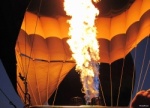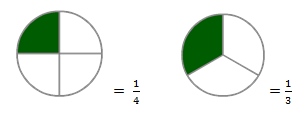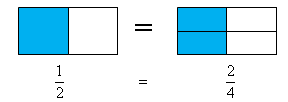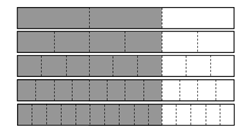Fractions and Decimals Content Module
BACK TO Content Modules
Contents |
Plot the Course
The rationale
Whether you are doubling a cooking recipe or trying to figure out the final price for an item that's half off, understanding the concept of what a fraction and decimal represent as well as how to perform mathematical operations with fractions and decimals are skills people use every day. In addition to everyday activities, decimals are used in common hobbies like baseball batting averages, lap times in Nascar, or the long jump in track and field.
Module Goal
The goal of this module is to provide detailed instruction on the more difficult concepts using fractions and decimals (e.g., multiplication and division of fractions) to teachers of students with disabilities at the elementary and middle school level. This module promotes a mathematical understanding of these concepts so that a teacher can begin to plan how to teach the concepts to students. Additionally, this module will provide instructors with potential adaptations and modifications to consider when designing materials and instruction for students with severe disabilities.
Module Objectives
After viewing the content module, teachers will:
- Perform computations with fractions that have like and unlike denominators
- Perform multiplication and division operations with decimals
- Solve two step equations with fractions and decimals
Time for Take Off
Understanding the vocabulary used within fractions and decimals is important for both teachers and students in planning and implementing math lessons. As a teacher, knowing and using the mathematical terms not only ensures your instruction stays true to the math content, but will also help with collaborating with other math teachers or content experts. When choosing which vocabulary to teach, it is most important that the teacher selects the most salient, important, or most frequently used vocabulary for each lesson.
Below you will find a list of vocabulary included within this module. It may or may not be necessary to provide instruction for all terms as students may have learned them previously. Fractions and decimals are mostly covered in elementary school, so all vocabulary for this content module has been combined. If you are a secondary teacher and are not confident your students have been taught these vocabulary terms, you may want to review and teach those unknown terms to the focus and review of your lesson plan.
While providing vocabulary instruction, you may consider including pictures or objects to make the instruction more concrete for students with disabilities (See ideas to support vocabulary learning below).
Vocabulary
- Equivalent - having the same value
- Fraction - a number that represents part of a whole
- Mixed number - a number that includes a whole number and a fraction
- Proper fraction - a fraction where the numerator is less than the denominator
- Improper fraction - a fraction where the numerator is greater than the denominator
- Rational number - any number that can be written as a fraction where the numerator and denominator are integers and the denominator does not equal 0
- Least common denominator - the smallest common multiple of denominators
- Reciprocal - also called a multiplicative inverse; when two reciprocals are multiplied together, the product equals 1 (e.g., 2/3 x 3/2=1)
- Numerator - the top number of a fraction
- Denominator - the bottom number of a fraction
Ideas to support vocabulary learning
- Use visual representations of fractions to explain what the numerator and denominator of a fraction means
- Use visual representations to show equivalent fractions
- Place fractions on a number line to demonstrate which fractions are larger than others
Floating on Air
Before you can begin teaching operations with fractions and decimals, you need a deep understanding of these mathematical concepts. Some of these concepts may be familiar to you. Below is a list of skills that should be covered at each grade level in the mathematical strand of Number and Operations. For concepts that you need more information about, please view the accompanying PowerPoint presentations that will walk you through an example as well as make some suggestions for instruction.
Elementary School
In elementary school skills include:
- 3.SE.1g1 Use =, <, > to compare 2 fractions with the same numerator or denominator
- 3.NO.1l1 Identify the number of highlighted parts (numerator) of a given representation (rectangles and circles)
- 3.NO.1l2 Identify the total number of parts (denominator) of a given representation (rectangles and circles)
- 3.NO.1l3 Identify the fraction that matches the representation (rectangles and circles; halves, fourths, thirds, and eighths)
- 3.NO.1l4 Identify that a part of a rectangle can be represented as a fraction that has a value between 0 and 1
- 3.NO.1l5 Locate given common unit fractions (i.e., ½, ¼, 1/8) on a number line or ruler
- 4.SE.1g2 Use =, <, > to compare 2 fractions (fractions with a denominator of 10 or less)
- 4.SE.1g3 Use =, <, > to compare 2 decimals (decimals in multiples of .10)
- 4.SE.1h1 Express whole numbers as fractions
- 4.SE.1h2 Identify the equivalent decimal for a fraction
- 4.NO.1l6 Locate fractions on a number line
(See Curriculum Resource Guide)
- 4.NO.1l7 Order fractions on a number line
- 4.NO.1m1 Determine equivalent fractions
(See Curriculum Resource Guide)
- 4.NO.1n1 Select a model of a given fraction (halves, thirds, fourths, sixths, eighths)
(See Curriculum Resource Guide)
- 4.NO.1o1 Match a fraction with a denominator of 10 or 100 as a decimal
- 4.NO.1o2 Find the equivalent decimal for a given fraction
- 4.NO.2g1 Using a representation, decompose a fraction into multiple copies of a unit fraction (e.g., ¾= ¼ + ¼ + ¼)
- 4.NO.2h1 Add and subtract fractions with like denominators of (2,3,4 or 8)
- 4.NO.2h2 Add and subtract fractions with like denominators (2,3,4 or 8) using representations
- 4.NO.2h3 Solve word problems involving addition and subtraction of fractions with like denominators (2,3,4 or 8)
- 4.NO.1p1 Read, write, or select decimals to the hundredths place
- 4.NO.1q1 Compare two decimals to the tenths place with a value less than 1
- 4.NO.1q2 Compare two decimals to the hundredths place with a value less than 1
- 5.NO.1b1 Read, write, or select a decimal to the hundredths place
- 5.NO.1b2 Read, write, or select a decimal to the thousandths place
- 5.NO.1b3 Compare two decimals to the thousandths place with a value less than 1
- 5.NO.1b4 Round decimals to the next whole number
- 5.NO.1b5 Round decimals to the tenths place
- 5.NO.1b6 Round decimals to the hundredths place
- 5.NO.1c1 Rewrite a fraction as a decimal
- 5.NO.1c2 Rewrite a decimal as a fraction
- 5.NO.2b1 Add and subtract fractions with unlike denominators by replacing fractions with equivalent fractions (identical denominators)
- 5.NO.2b2 Add or subtract fractions with unlike denominators
- 5.NO.2b3 Multiply or divide fractions
- 5.NO.2c1 Solve one step problems using decimals
- 5.NO.2c2 Solve word problems involving the addition, subtraction, multiplication, or division of fractions
Middle School
In middle school skills include:
- 6.NO.2c3 Solve one step addition, subtraction, multiplication, or division problems with fractions or decimals
Insert multiplication and division with decimals PowerPoint presentations
- 6.NO.2c4 Solve word problems involving the addition, subtraction, multiplication, or division of fractions
- 7.NO.1h1 Identify an equivalent fraction, decimal, and percent when given one of the three numbers
- 8.NO.2i3 Solve one step addition, subtraction, multiplication, and division problems with fractions, decimals, and positive/negative numbers
- 8.NO.2i4 Solve two step addition, subtraction, multiplication, and division problems with fractions, decimals, or positive/negative numbers
Insert solving two step equations using fractions and decimals PowerPoint presentation here Great! Now that you have viewed the PowerPoint presentations most useful to you, the next section will provide some ideas to consider when planning for Universal Design for Learning.
Sharing the Sky
UNIVERSAL DESIGN FOR LEARNING
| Some examples of options for teaching Fractions and Decimals to students who may present instructional challenges due to: | ||||
| Visual Impairment or Deaf/Blind | Physical Impairment:
Little/No Hand Use |
Lacks Basic Numeracy Concepts | Motivational/Attention Issues | |
| Representation | Use a talking calculator when solving equations; use a ruler with raised measurement lines, use objects to represent fractions and decimals; use raised lines to represent portions of the whole object. Use items that are velcroed together to represent the whole and have the student separate the whole into parts. | Count the parts of fractions or decimals using a step by step process which progresses through numbers; student scans an array of possible options and uses a switch to select the number to identify the numerator; use computer representation of figures that can be manipulated with switch; place fraction representations on a slant board or eye gaze board; create a grid on a large surface on the floor that the student can walk over or ride over in wheelchair. | Use fraction and decimal manipulatives that can be separated and placed on a number line. Have student use talking calculator to count along. Students can use one to one correspondence to match equal number of parts on representation of fraction or decimals. Color code equations and corresponding parts of calculator to support students correctly entering equations. | Find fractions of motivating objects (e.g., pizza, coloring markers in a box, piece of a Lego set). Incorporate technology including computer representations, videos, animations, and talking calculators. Use token economy system that embeds fractions ("you earned ¼ of your Lego piece, you have ¾ left and then you get Lego time.") |
| Expression | Student states answer or scans raised numbers to select correct answer; use voice output devices for student to select the correct answer; teach tangible symbols that mean fraction and decimal. | Student scans and selects number that represents numerator or denominator; uses a switch to indicate correct answers; use an eye gaze board to select answer; use a blink response to count parts or select answer; phrase questions so that they require a "yes/no" response, these can easily be answered using an eye gaze, head turn, two switches, etc; count parts of fractions out loud having student move in some voluntary way (e.g., nod head, tap hand, tap foot) to count along. | Student selects numbers versus writing them; selection of correct answer is done after a model; student points to each part of a fraction or decimal while teacher or peer counts aloud; student answers "yes/no" questions regarding fractions or decimals after parts have been counted aloud (e.g., 1,2,3,4. There are 4 colored parts. Is this the number we write as the numerator?); matches the parts of a fraction to the correct number (matches 4 to 4). | Have students express fractions using high interest manipulative (e.g., Legos, stickers of favorite characters, a fraction of an iPod, or jewelry beads). |
| Engagement | Teach students to use their hands to scan the raised parts of each whole item; use talking calculator for computing the area; start with simple, clearly defined fractions; use items that are familiar and reinforcing to students. | Use bright colors to call attention to numerators; use a computer with AT where the student can click to answer; use figures that are large enough to accommodate the movements that the student is able to make; pair student with another student without a physical impairment and have them work together to create fraction and decimal representations. | Student uses talking calculator, limit fractions and decimals to numerals less than 10, use bright colors to represent fractions and numerals. | Use token economy system that embeds fractions ("you earned ¼ of your Lego piece, you have ¾ left and then you get Lego time.") |
Prepare for Landing
Below you will find ideas for linking measurement activities to real-world applications, the college and career readiness skills addressed by teaching these concepts, module assessments for elementary and middle/high school teachers, sample general education lesson plans incorporating Universal Design for Learning framework, blog for teachers to share their ideas, and a place to upload and share lesson plans from teachers who completed this module. Teaching a variety of strategies within the number and operations strand may seem like a lot of work and developing creative, yet concrete demonstrations can be difficult. One way to help assist in a special educator's development within this curricular area is through collaboration with other teachers in your building. Often these skills are practiced outside of a math classroom in other curricular areas like science. Some activities with real world connection include:
- Measuring out fractions of ingredients for cooking.
- Using a ruler to measure out fractions of a foot and inch to cut wood to make a birdhouse.
Students can learn to sort items using the Dewey decimal system in the library.
- Use pennies, dimes, and dollars to demonstrate one-hundredths, tenths, and 1 whole. Write as decimals and fractions.
- Students make a bracelet using two different color beads then describe the colors used to make the bracelet in fractions.
- Calculate sales price for a half price sale or 25% off.
In addition to the real-world applications of these measurement concepts, skills taught within this content module also promote the following college and career readiness skills.
Communicative competence Students will increase their vocabulary to include concepts related to "fractions and decimals." In addition, they will be learning concepts such as: "half", "whole", "more", "less", and "almost."
Fluency in reading, writing, and math Students will have an opportunity to increase their numeracy and sight word fluency while participating in problem solving related to "fractions and decimals" such as number recognition, counting, one-to-one correspondence, and reading concepts that include the use and understanding of descriptors related to size.
Age appropriate social skills Students will engage in peer groups to solve problems related to "fractions and decimals" that will provide practice on increasing reciprocal communication and age appropriate social interactions. For example, students might work together with their peers to measure out ingredients for a science experiment or cooking activity.
Independent work behaviors By solving real life problems related to "fractions and decimals" students will improve work behaviors that could lead to employment such as assisting in the library, measuring in construction, and preparing food in a kitchen. When providing opportunities for real life problems leave some materials out and prompt/teach the students to determine who they should ask and what they should ask for to be able to solve the problem.
Skills in accessing support systems At times, students will need to ask for assistance to complete activities related to "fractions and decimals" which will give them practice in accessing supports. Students will gain practice asking for tools such as talking calculators, a digital tape measure, or measuring cups. They can ask a peer to complete the physical movements of the tasks they are not able to do themselves. Be sure to teach students to ask versus having items or supports automatically given to them.
In addition to collaborating with other educational professionals in your building, the following list of resources may also help provide special educators with ideas for activities or support a more thorough understanding of the mathematical concepts presented in this content module
Additional Resources
- http://www.mathleague.com/ - this website provides activities and ideas for instruction across all math strands
- http://www.mathisfun.com/ - this website is a great resource for teachers who are struggling with how to teach mathematical content including task analysis for completing a variety of mathematical procedures (e.g., converting fractions to decimals, multiplying and dividing fractions)
- http://mathforum.org/ - website specifically for teachers which provides a variety of ideas and activities to use in your classroom
- http://www.figurethis.org/index.html - this website is designed for families and students to practice mathematical concepts outside of the classroom
- www.teachertube.com - Youtube for teachers! Simply search for your content area and this websites provides a variety of videos including videos of math experts working through math problems step by step (free registration required).
- http://www.k8accesscenter.org/training_resources/math.asp\#webinar - this website not only provides some ideas and activities to use in your classroom, but also includes presentations and webinars from the North Carolina Department of Public Instruction about research-based strategies that have proven effective in teaching math for students with varying level of disability.
- http://exchange.smarttech.com/search.html?subject=Mathematics - this SMART board exchange has developed lessons by classroom teachers differentiated by grade level. You can also search by skill and/or state standards.
Suplemental Materials
PowerPoints
Module Assessments
Below are links to assessments for the purpose of self-checking your understanding of the content in this module. After answering the assessment questions, you may want to review the key to check your work.
Sample General Education Lesson Plans
Lesson Plan Outlines
Adapt the following general education lesson plan; adapt, and upload. These lesson plans may be shared with higher education professionals developing strategies to provide meaningful academic instruction in mathematics to students with severe disabilities.









